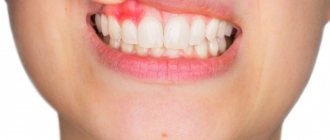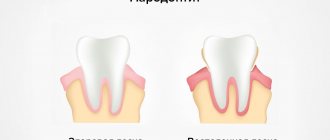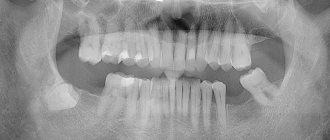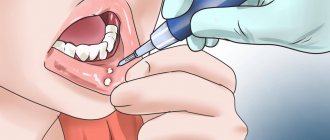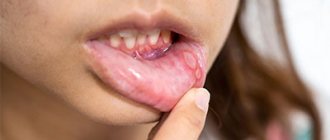Dear patients! This section of our website is dedicated to periodontal
and methods of their
treatment
.
In recent years, there has been a noticeable increase in the incidence of gingivitis, periodontitis
and periodontal disease among young people, and therefore it is extremely important to know how periodontal tissues interact normally, what causes their damage and how to deal with these diseases if you are susceptible to them.
Let's start with a definition. So, what is Periodontium? The very concept of “Periodontal” translated from Greek means: par[a] about + odontos tooth, that is, “Near the tooth”, and accordingly, includes a complex of tissues that have genetic and functional commonality: gum with periosteum (1), cementum of the tooth root (2), periodontium (3) and alveolar bone (4).
Fig 1. Structure of periodontal tissues
Fig 2. Healthy periodontium
From the definition it follows that all these structures are very closely interconnected and are in a state of fragile dynamic equilibrium, the violation of which leads to disease. What are the causes of periodontal disease?
Let's look at 2 groups of reasons:
WHAT IS PERIODONTAL
The periodontium is the complex of tissues surrounding the tooth. These include not only the gums, but also the bone socket in which the tooth root is located, and the tooth ligaments that hold the tooth in the socket, intertwined with the tooth root and bone. All these tissues represent a single system that performs several important functions at once: fixation of teeth, perception and regulation of chewing load, control of the work of masticatory muscles, protection against penetration of pathogenic bacteria and a number of damaging factors into the bone tissue.
Structure and functions of periodontium
Periodontium is usually called a complex of tissues that includes:
- alveolar processes (areas of the jaw that bear the dentition);
- gums (mucous membranes covering the alveolar processes);
- periodontium (tissues consisting of protein fibers and located in the space between the alveolar plate and the cement of the tooth root);
- cement (special bone tissue covering the roots and necks of teeth).
In the human body, the periodontium performs the following functions:
- shock-absorbing (evenly distributes the load on the jaws);
- supporting-retaining (provides strong fixation of the tooth in the alveolar socket);
- trophic (contains an extensive network of lymphatic and blood vessels, a huge number of nerve receptors);
- barrier (protective) and others.
Preserving periodontal tissue in a healthy state is the key to long-term and proper functioning of the masticatory apparatus.
HOW DOES GINGIVIT MANIFEST, AND WHY DOES IT OCCUR?
With superficial inflammation of the gums (if only soft gum tissue is involved in the process), we are dealing with gingivitis. Inflammation can occur in the area of 1 - 2 teeth (local gingivitis) or all teeth (generalized gingivitis).
Inflammation of the gums usually begins with damage to the gums, for example, when eating, brushing teeth, an incorrectly applied filling or crown, or a chemical burn. In this case, pathogenic microorganisms penetrate the injured gum and intensify the inflammatory response. The presence of soft plaque, tartar, and poor oral hygiene are mandatory conditions, and very often an independent cause of the onset and maintenance of the disease.
Gingivitis is often observed in people with malocclusions, crowded teeth and their incorrect position. A short frenulum of the upper and lower lips is also a risk factor for periodontal disease.
Smoking plays an important role (spasm of blood vessels occurs, gum nutrition deteriorates), decreased body defenses (immunodeficiency), lack of vitamin C and other risk factors.
In the acute stage of the process, pain, burning, swelling of the gingival margin, and bleeding when brushing teeth are usually noted. If the cause of the disease is not eliminated, then acute gingivitis becomes chronic, which does not go away on its own without treatment. In this case, the gums turn blue and periodically bleed when brushing your teeth and eating. There is an unpleasant odor from the mouth.
Severe forms of gingivitis, such as ulcerative gingivitis, are observed in severe general diseases of the body. For example, with diabetes or a serious immunodeficiency disease. In this case, the temperature rises, painful ulcers covered with a film appear on the dirty gray gums, and general health worsens.
With gingivitis, the teeth remain stable, since the process does not penetrate deep into the periodontium, the so-called periodontal pocket does not form, and the bone tissue of the tooth socket does not dissolve. Can there be consequences if gingivitis is not treated?
If gums are not treated in time, gingivitis will develop into periodontitis. This is a much more serious and dangerous disease than gingivitis. Often it becomes irreversible, since periodontitis affects and destroys the deep tissues of the periodontium - the ligaments of the tooth and the bone tissue of the jaw.
WHAT FACTORS PROMOTE THE DEVELOPMENT OF PERIODONTITIS?
The causes of periodontitis are the same as those of gingivitis. Often periodontitis is associated with chronic gingivitis. If the traumatic factor persists, microorganisms actively continue to multiply in the damaged gum. Their toxins and enzymes destroy the gums deeper and deeper.
As a result, the connection between the gum and the tooth (the bottom of the periodontal sulcus) is disrupted - a very important protective formation that protects the tooth ligaments and bone from infection. A periodontal pocket appears, and now bacteria, plaque, etc. rush into the depths of the periodontium - this is where periodontitis begins. Next, gradual destruction of the tooth ligaments occurs, and the bone tissue melts.
Periodontitis can be acute or chronic. Typically, acute periodontitis occurs when there is deep, strong trauma to the gums (for example, a long artificial crown, a toothpick). In this case, the periodontal connection may be immediately disrupted - gingivitis and periodontitis occur simultaneously.
Generalized periodontitis is characteristic of serious general diseases of the body - diabetes, other endocrine diseases, radiation sickness, severe diseases of the gastrointestinal tract and cardiovascular system. It is almost impossible to cure such periodontitis without general treatment of the underlying disease.
In the chronic process, pain and swelling are not as pronounced as in acute periodontitis, the amount of tartar and soft plaque increases, the bad breath increases, the gums begin to settle, exposing the neck of the tooth, teeth become sensitive to cold, hot, sour and salty. Tooth mobility appears, unnoticeable at first, but steadily increasing.
Suppuration of periodontal pockets is often observed. Pus is released from under the gum when pressing on the gum edge with a finger. Sometimes, in the absence of outflow of pus, periodontal microabscesses occur - in this case, the patient already requires surgery.
Periodontitis can be one of the causes of some common diseases. The microorganism that causes stomach ulcers is often found in dental plaque. Other bacteria living in dental plaque can lead to the formation of microthrombi (blood clots). Penetrating into the blood (with bleeding gums), they increase the risk of cardiovascular diseases, including myocardial infarction. The entry of microorganisms into the blood can lead to septic endocarditis. There is information about the relationship between chronic dental and periodontal diseases and kidney damage. Remember that the focus of chronic infection in the oral cavity is the entry point for pathogenic bacteria into the body.
DIFFERENCES PERIODONTOSIS FROM PERIODONTITIS
Periodontal disease is a degenerative lesion of all periodontal tissues; this process never occurs in an acute form and is not associated with exposure to bacteria. There is a slow, uniform resorption of the bone tissue of the teeth cells and subsidence of the gums with exposure of the roots of the teeth. Periodontal disease is always a generalized process, that is, all teeth on both jaws are affected. Bone tissue atrophy is usually painless, continuous and, if left untreated, leads to the complete disappearance of the ligamentous apparatus, the walls of the tooth sockets and their loss. Inflammatory phenomena are associated with periodontal disease quite rarely.
The exact cause of the disease is still unknown. It is believed that the onset of the disease is associated with impaired blood circulation in periodontal tissues and endocrine disorders. The development of periodontal disease is promoted by diabetes, cirrhosis of the liver, gastric ulcer, neurogenic diseases, cardiovascular pathology (atherosclerosis), hypovitaminosis and a decrease in the body's overall resistance.
Local factors, for example, the impact of microorganisms on the periodontium, can only aggravate the course of the disease, therefore, in periodontal disease, the primary process is the resorption of bone tissue and the ligamentous apparatus of the tooth, and superficial changes in the gums are secondary.
Periodontal disease progresses slowly. Clinically, it manifests itself with significant changes in the periodontium. This is subsidence of the gums, exposure and increased sensitivity of the necks of the teeth, itching in the gums. Teeth remain stable for quite a long time.
A characteristic sign of periodontal disease is the presence of so-called wedge-shaped tooth defects - damage to the enamel of the teeth near the gums in the form of fairly deep oval cavities. Currently, this phenomenon is explained by a malnutrition of the tooth, inferior enamel and dentin, combined with very strong pressure on the toothbrush during frequent brushing. Periodontal disease is characterized by the absence of periodontal pockets.
WHY IS PLAQUE A MAIN CAUSE OF PERIODONTAL DISEASE?
Bacterial plaque is a sticky, colorless film that constantly forms on teeth. If plaque is not removed, it will harden and form a rough, porous growth called tartar. Bacteria in tartar produce toxins (poisons) that irritate the gums, causing them to become red, tender, swollen, and bleeding. As the disease progresses, toxins can lead to periodontal destruction and the formation of pockets that fill with plaque. The bone that supports the teeth is subject to constant destruction. Consistently removing plaque through brushing, flossing, and professional care can minimize the risk of gum disease. However, if no treatment is given, the affected teeth may become loose and eventually fall out.
WHAT IS A PERIODONTAL EXAMINATION?
The history of the disease (anamnesis) is carefully determined. When did it first start, what was done for treatment, do parents and close relatives have this disease, etc. Careful collection of data makes it possible to determine risk factors and sometimes even predict the course of the disease. This is followed by a careful examination of the oral cavity: the frenulum of the lips and tongue, the dental arches as a whole and, if necessary, each tooth separately, as well as fillings, crowns and orthodontic appliances are assessed.
One of the main examination methods is probing the periodontal pocket of each tooth at six points. The presence of tartar and soft plaque, bleeding, suppuration, tooth mobility, etc. is assessed. This labor-intensive analysis is painlessly performed in 15 - 20 minutes using a special electronic probe of the automated computer clinical diagnostic system Florida Probe (USA). The patient’s personal data is stored in the computer’s memory, which makes it possible to predict the course of the process and select treatment, as well as evaluate the dynamics of the disease and the effectiveness of the treatment.
An orthopantomogram is a necessary element in the diagnosis of periodontal diseases. This image shows the teeth, jaw bones, and the partitions between the teeth. Digital orthopantomographs (such as the ones in our clinic) allow you to obtain excellent images with minimal radiation exposure to the patient and evaluate them on a computer screen using auxiliary computer programs.
WHAT IS MEAN BY PERIODONTAL TREATMENT
After collecting all the necessary information, the periodontist will discuss the condition of your gums with you and suggest the most optimal treatment. Most importantly, it must be comprehensive - that is, treatment must cover all identified causes and associated factors that support the disease. Only in this case can it be possible to completely cure or stabilize periodontal disease for a long time.
Treatment will be much more effective if the patient strictly follows all instructions and strictly follows the chosen treatment plan.
Typically, a comprehensive treatment plan consists of general and local treatment and includes all or part of the methods listed below.
Who treats periodontal problems?
A periodontist treats diseases of the periodontium and oral mucosa. A periodontist knows all diseases of the oral cavity and treats the root system of teeth, periodontium, and sockets. Close collaboration between your primary care dentist and your periodontist will bring the most positive results.
The portal will allow you to find patient reviews about their treating doctors, which will help you choose the best specialist. The advantages of searching for a specialist on the portal: you see the rating of the doctor and the clinic, each clinic has specialists in different fields, which is important when treating periodontal disease. By going to the clinic’s website, you can find out the hardware and technical capabilities, and compare prices for the services provided.
ELIMINATING TRAUMATORY FACTORS DURING TREATMENT
Treatment begins with the elimination of traumatic factors - low-quality fillings and crowns with an overhanging or very deeply embedded edge in the gum, bridges, traumatic teeth, etc. are removed.
The so-called selective grinding of teeth is carried out in order to eliminate excessive traumatic load when chewing from overloaded teeth. At the same time, small areas of the teeth are slightly undermined, which do not allow the upper and lower rows of teeth to meet correctly, thereby causing them to be overloaded.
This is an absolutely harmless procedure, since the ground areas of the teeth are polished and coated with fluoride preparations. In this case, caries does not occur.
Professional oral hygiene The next stage of treatment (performed in 100% of cases) is professional teeth cleaning: it allows you to remove even tartar located deep under the gum (this is the strongest traumatic factor). In addition to tartar and soft plaque, dense dark plaque (from smoking, drinking tea, coffee, and other dyes) is simultaneously removed - this allows you to restore the beautiful appearance of your teeth. After removing tartar and plaque, the doctor will definitely polish the cleaned surface of the root and crown of the tooth.
Nowadays, several methods of removing dental plaque are common. Cleaning teeth with a stream of air mixed with cleansing powder and water (the most famous representative is the Air Flow system) perfectly cleanses teeth of soft plaque, dark plaque from tobacco or coffee, even in hard-to-reach places. Ultrasonic scalers are capable of removing tartar of almost any size.
Removing tartar is one of the most important and effective stages in the treatment of periodontal diseases.
Anti-inflammatory therapy Drug therapy of gums allows you to relieve inflammation - cope with pain, swelling, and reduce bleeding gums. Typically, periodontal pockets are washed with antiseptic solutions (chlorhexidine, iodinol, etc.), and various medicinal substances are used (enzymes, antimicrobial, hormonal, anti-inflammatory drugs). Often the gums are covered with a special bandage after the medication is administered.
Self-absorbing Diplen-Dent films impregnated with various medications (antibacterial, improving blood circulation, etc.) are very convenient. Such films are glued by the patient independently to the affected areas of the gums (for example, before going to bed) and, gradually dissolving, release the medicine directly into the gums. In the morning, all you have to do is remove the remaining film from the oral cavity.
Physiotherapeutic treatment There are many methods of physiotherapeutic treatment of periodontal diseases. Laser therapy is most widely used in our clinic. Therapeutic laser radiation has a very wide range of therapeutic effects - relieves pain, improves blood circulation, metabolism, stimulates immune defense.
Gum massage can be performed by a doctor or independently. At home, use your index finger to massage the area of the interdental papilla of the gum with up and down movements (6 to 10 movements per papilla). The massage ends with hygienic rinses. Massage should not be used if the disease is exacerbating or if there are erosions or ulcers on the gums.
Surgical treatment Periodontal surgery is a radical and one of the most effective methods of treating moderate and severe periodontitis. With the help of small operations, it is possible to eliminate periodontal pockets, remove overgrown infected soft tissues, eliminate suppuration of the gums (microabscesses), replant bone tissue or bone substitutes, lift receding gums and close small root exposures.
Every year new developments in the field of surgical treatment, modern materials and treatment methods appear. One of the promising innovations is surgical treatment using cellular technologies, which allows stimulating the restoration of bone tissue. This technology is widely used in our clinic. Surgical treatment is always carried out after removal of dental plaque and therapeutic treatment, when all acute symptoms of gum inflammation subside. All interventions are performed under local anesthesia and rarely take much time. Usually all postoperative phenomena subside after 2 - 3 days, and the sutures are removed, or they dissolve within a week.
The effect of such operations often lasts for a long time. A lot will depend on maintaining oral hygiene, following preventative rules and overall health.
Rational prosthetics and splinting Prosthetics of missing teeth and their permanent splinting (i.e. joining teeth together using a prosthesis or special light-curing threads) are the final stage of the treatment of periodontal diseases. It allows you to fully restore the function of chewing, eliminate aesthetic defects (in the absence of teeth visible when smiling), and unite all the teeth together, as intended by nature.
In this case, the load is distributed evenly throughout the entire dentition, which allows the supporting teeth to function much longer. Even the absence of one tooth causes a number of changes in the bone tissue of the jaw. If, after successful therapeutic and surgical treatment of the gums, rational prosthetics and splinting are not carried out, then the disease may worsen again in the very near future.
Prosthetics are carried out using both removable and fixed dentures, depending on the condition and number of teeth.
After completion of treatment, we advise you to strictly follow all the doctor’s recommendations. Be sure to visit your doctor at least 1-2 times a year for a follow-up examination and professional oral hygiene.
Treatment of periodontal diseases
The general treatment program for periodontal diseases includes:
- removal of microbial plaque and mineralized deposits from the surface of teeth;
- caries therapy;
- preventing functional overload of certain areas of the dentition;
- rejection of bad habits;
- carrying out orthodontic treatment (if indicated);
- anti-inflammatory therapy;
- combating systemic diseases;
- the use of drugs that enhance immunity, stimulate osteogenesis and activate the adaptive and protective functions of the body;
- carrying out general hygiene measures (monitoring the regime of work, nutrition, rest, hygiene).
The treatment regimen for periodontal diseases is drawn up taking into account all manifestations of the disease and the results of a comprehensive examination of the patient. Timely seeking of professional help by a patient significantly improves the prognosis of the disease, shortens the duration of treatment and avoids the development of complications.
HOW MUCH WILL THE TREATMENT COST?
The cost of periodontal treatment will depend on the type and amount of work planned. When considering an investment in your own health, consider that treating gum disease is cheaper and better for your health than restoring a tooth lost due to untreated periodontal disease.
New direction – aesthetic surgical periodontology
Recently, such a direction as aesthetic surgical periodontics has appeared and is actively used in surgical periodontology. She deals with the correction of changes in the position of the gingival margin relative to the neck of the tooth, and gum growths. Aesthetic surgical periodontics includes a large number of new surgical techniques, depending on the clinical situation and the desired aesthetic effect.
Symptoms of periodontal disease
The first symptoms indicating the occurrence of periodontal disease are:
- tingling, itching, numbness in the gums;
- bleeding of gum tissue;
- swelling of the interdental papillae;
- thickening of the gingival margin;
- detachment of gums from dental crowns.
In the future, the clinical picture may be supplemented by:
- gradual exposure of the necks of the teeth;
- redness, hyperemia of the gums;
- formation of pathological gum pockets;
- increase in interdental spaces;
- gradual loosening of teeth.
Symptoms of tissue diseases also include increased sensitivity of dental tissues to irritants, as well as aching pain in the affected area.
ARE THERE METHODS FOR PREVENTION OF PERIODONTAL DISEASES?
- Prevention of periodontal disease consists of several simple points:
- Brush your teeth 2 times (morning and evening) after meals. Use a toothpaste recommended by your doctor to protect your gums. Use an electric toothbrush - it perfectly cleans your teeth and massages your gums.
- Do professional oral hygiene at least 2 times a year, and at the same time you can undergo an examination by a periodontist. Do not use any medications for the treatment or prevention of periodontal disease (gels, ointments, tablets, etc.) without consulting your dentist.
- Do not eat only soft and delicate foods - your teeth should receive normal, natural stress.
- Your diet should be well balanced, contain the required amount of proteins, fats, carbohydrates, and vitamins. If you are deficient in vitamins, take multivitamin complexes.
- Lead a healthy lifestyle.
What are the differences between periodontitis and periodontal disease?
Patients often confuse these diseases. However, many doctors also do not consider periodontal disease as a separate dental problem, especially since it is excluded in the latest classification of diseases. But clinically the disease still exists and in its “pure” form occurs in no more than 3-5% of patients.
Periodontitis is a consequence of gingivitis, a slight inflammation of the gums. It most often occurs as a result of poor oral hygiene, that is, the accumulation of large amounts of plaque and tartar on the teeth/under the gums.
But the causes of periodontal disease have not been fully determined. On the one hand, it is caused by a general weakening of the body and disruption of metabolic processes, on the other hand, the disease develops as a consequence of long-term and complex treatment of periodontitis using conservative methods without the use of drugs aimed at tissue regeneration: constant curettage and trauma disrupt the nutrition of the gums and they are reduced in volume. Unlike periodontitis, with periodontal disease there are no voluminous periodontal pockets, but there may well be deposits on the necks and roots of the teeth, the gums do not bleed - on the contrary, they are pale and whitish. In the same way, exposure of tooth roots occurs, that is, a reduction in the volume of the mucous membrane - gum recession. And as a result, increased sensitivity occurs, increased susceptibility to thermal irritants and pressure due to the exposure of tooth roots, on which the enamel layer is practically absent. The more the disease progresses, the more pronounced the mobility of the teeth.
